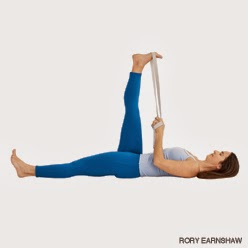Improving mobility of the lower body is also important in controlling back pain.
Tightness in large muscles in the lower body are also very frequent causes of in low back pain. The most common culprits are the hamstrings (back of your thigh) and the hip flexor, a deep muscle in the front of your hip that attaches to the low back. The hip flexor can causes increased curve in the low back and pulls your pelvis forward if it is tight. The hamstrings often cause a flattening of the curve in the low back and tilt the pelvis backwards when it is tight. This creates abnormal stresses upon the spine.
Again review detailed instruction on each pose at www.yogajournal.com
- Hip Flexor Stretching: Stretch should be felt in front of hip and thigh of the back leg.

- Hamstring stretching: There are many forms of hamstring stretching. Performing stretching on one’s back is the safest place to begin because the back is supported, minimizing stress on the spine.

Lastly, yoga is beneficial in stabilizing the core by increasing abdominal awareness with the use of breath work. Breath assists the expansion and contraction of the abdominal cavity which houses the abdominal and lumbar musculature. So, as we deepen our breath in and use our breath to propel our motion it stimulates the activation of these muscles. Yoga teaches us to draw our attention to our core and move mindfully from our center to build strength and stability in the spine.
Standing and balance poses also encourage simultaneous contraction of muscles in the front and back of the body. This teaches the core to work in the ways that we move on a daily basis. Therefore, the combination of awareness, breath, and balance poses make yoga endurance work out for our core.
This article highlights only some of the ways yoga can assist in treating low back pain. However, it is important to note that not all back pain is the same. Different diagnoses have different causes and aggravating factors. It is important understand your limitations before initiating a yoga program. Yoga is not appropriate for treating severe back pain or acute aggravation of back pain. Yoga is a great way to manage low back pain that has been diagnosed and controlled. Please consult your physical therapist or primary care physician before you begin. Namaste.
If you have any questions or are interested in more information on this topic check out www.trucarept.com or contact Ericka at (401) 884-9541
